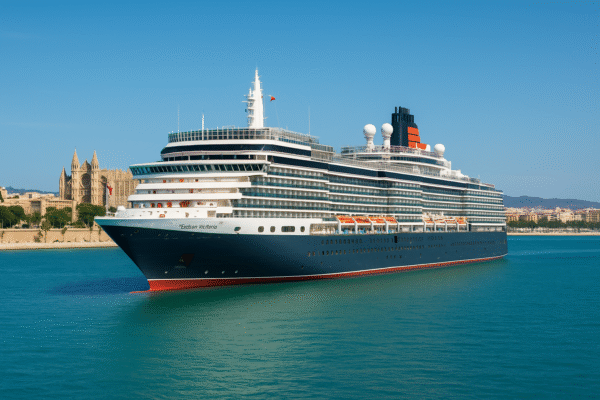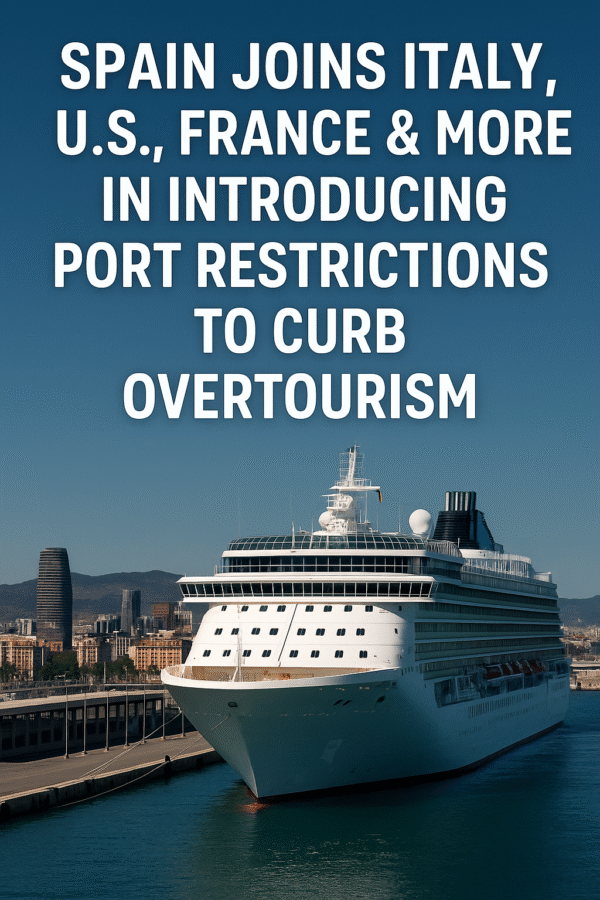Barcelona — In a sweeping move to combat overtourism and protect urban environments, Spain has joined forces with leading cruise destinations such as Italy, the United States, Croatia, France, and the Netherlands in implementing cruise passenger limits. The latest reforms in Barcelona, Europe’s busiest cruise port, mark a significant turning point in global tourism management — reducing cruise traffic in favor of sustainability, cultural preservation, and coastal resilience.
Barcelona Scales Down Cruise Terminals for a Cleaner, Calmer Future
As part of a five-year cruise reform strategy, the Port of Barcelona will reduce its number of cruise terminals from seven to five. The reform includes the demolition of Terminals A, B, and C at Adossat Wharf, replaced by a modernized Terminal C outfitted with shore power connections and passenger capacity for 7,000 people. The new terminal — publicly owned — will accommodate larger cruise vessels while allowing ships to shut down engines at berth, significantly reducing air and noise pollution.
This €140 million transformation project is scheduled for full completion by 2030. In tandem, the city will invest €50 million in quay upgrades and €90 million into the new Porta d’Europa bridge, set to open in 2027, creating pedestrian and cycle connections from the cruise terminal into the urban core. The overarching goal: reduce congestion while redistributing visitor footfall across less-trafficked neighborhoods.
According to Spain’s Ministry of Transport, the move is a direct response to a 20% surge in cruise arrivals between 2018 and 2024. By concentrating cruise traffic and encouraging sustainable practices, Barcelona aims to strike a balance between economic benefits and environmental preservation.
Italy and Venice: Pioneers in the Cruise Reform Movement
Italy has long been at the forefront of cruise regulation. Venice’s landmark ban on large cruise ships entering the Giudecca Canal or docking near St. Mark’s Square reshaped the city’s tourism future. Cruise traffic now reroutes to Marghera and offshore locations, dramatically reducing wave damage and easing strain on the city’s delicate lagoon ecosystem.
Supported by Rome’s national decree, Venice’s bold move redefines how historic cities can reclaim space for residents while maintaining tourism as a viable economic pillar.
United States Cities Push Back: From Key West to Juneau
Across the Atlantic, U.S. cities have been taking local control. In Bar Harbor, Maine, officials imposed a strict daily cap of 1,000 cruise passengers, while Juneau, Alaska, reached a landmark agreement with cruise operators to limit weekday arrivals to 16,000 and Saturdays to 12,000 beginning in 2026.
Monterey, California, has suspended all cruise landings indefinitely, citing environmental and community concerns. Meanwhile, Key West continues its effort to regulate ship size and environmental compliance despite state-level legal challenges. These measures represent a grassroots-led recalibration of how communities across America are confronting overtourism head-on.
Dubrovnik, Croatia: Defending the Old Town from Overload
Dubrovnik, a UNESCO World Heritage Site, faced immense strain from over 1.1 million cruise visitors annually. In response, Croatia enforced a hard limit: no more than two ships per day can dock in the city. The move, alongside coordinated scheduling with cruise lines, has helped smooth visitor flows and reduce overcrowding in the Old Town, preserving its medieval charm and quality of life for residents.
France Limits Riviera Landings: Cannes and Nice Take Action
In France, Cannes and Nice are enacting stricter limits on cruise ship visits. Beginning in 2026, Cannes will allow only one ship over 1,000 passengers per day, capping daily cruise arrivals to 6,000. Nice will go even further by banning vessels with capacity over 900 passengers starting in 2025. These rules aim to preserve the aesthetic and environmental character of the French Riviera and improve visitor experience by reducing crowding.
Amsterdam, Netherlands: Leading the Environmental Charge
Amsterdam is enforcing some of the strictest environmental rules in Europe. The Dutch capital plans to cap annual ship calls to 100 by 2026 and ban docking in the historic center by 2035. Shore power will be mandatory from 2027. The city’s crackdown is part of a larger agenda to reduce pollution, reclaim city space, and refocus urban life on residents rather than transient cruise passengers.
A Coordinated Global Movement to Rein in Mass Tourism
What began as isolated measures in a handful of cities has become a coordinated global movement. Governments are realizing that cruise tourism, while economically valuable, must be better managed to avoid long-term harm to infrastructure, heritage, and local communities.
Spain’s decisive reforms put it in alignment with some of the world’s most progressive cruise destinations. The country’s actions also reflect an increasing global consensus: the cruise tourism model must evolve from unchecked expansion to strategic sustainability.
Barcelona’s approach — combining infrastructure modernization, real-time visitor dispersal systems, and environmental upgrades — could serve as a blueprint for other coastal cities facing the same dilemma.
Conclusion: Sustainability as the New Gold Standard
From Venice’s canals to the piers of Alaska, a new era of cruise tourism regulation is unfolding. Spain’s collaboration with global partners reflects a seismic shift toward preserving culture, protecting coastlines, and ensuring long-term economic viability through responsible tourism.
With public opinion, scientific data, and government policy aligned, the momentum behind cruise tourism reform is growing. As global traveler numbers rise post-pandemic, the message is clear: sustainability is not a luxury — it is a necessity.
For more travel news like this, keep reading Global Travel Wire
















